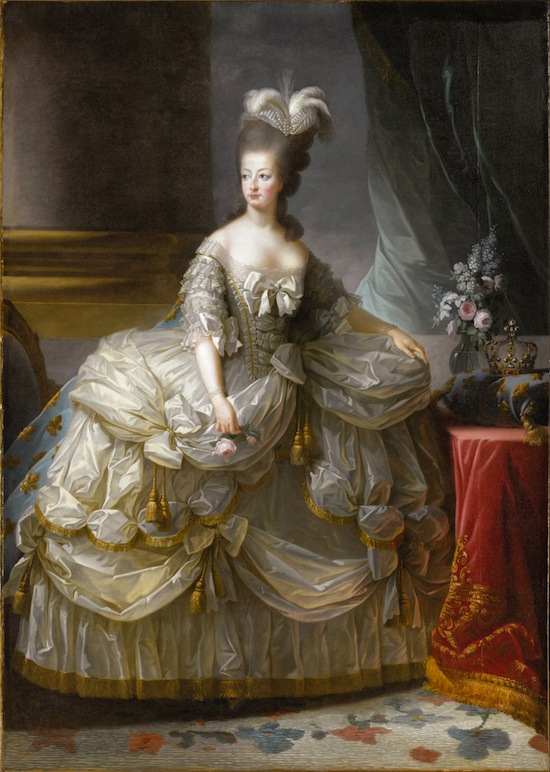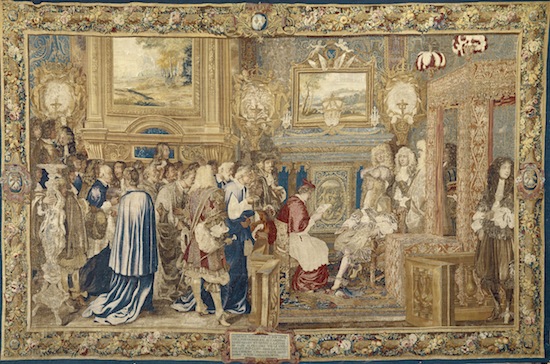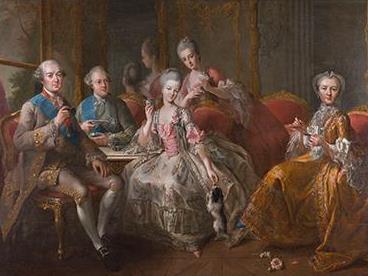Detail, Jean-Baptiste Charpentier, the elder, The Duke of Penthièvre and his family c.1768; on loan from the Palace of Versailles, Photo © Château de Versailles, Dist. RMN-Grand Palais / Christophe Fouin
There is something about ostentatious expenditure that compels us. We are attracted to power and wealth, to those who live as we never could, the more self-indulgent the better.
The NGA’s summer blockbuster, Versailles: Treasures from the Palace, allows us all to be “king for a day”, immersed in the over-the-top opulence that defined the political seat of France, when Louis XIV moved his Court from Paris to the country.
In stark contrast to the modern-day Canberra, Versailles was an extravagant world. Visitors have a sense of voyeurism into that vignette of the absolute monarchy with their gilded opulence, excessive pomp, and extravagant entertainment. This exhibition provides an immersive experience into that sense of luxury.
‘It is wonderful how foreign it is and how approachable it is at the same time,’ said Lucina Ward, Senior Curator of International Art at the National Gallery of Australia.
Kardashians of another time
Just as television celebrities set fashion trends, amuse us with scandals and provide an endless subject of conversation, the court of Louis XIV at Versailles shaped the culture and conversation of pre-revolutionary France.
Versailles was a world within itself. The Palace had the capacity to house up to 20,000 people, and around 3,000 aristocrats, courtesans, government ministers and servants lived there at any given time, jostling and vying for the Monarch’s patronage in a constant pantomime of power.
‘The first part of the exhibition captures the way Louis XIV, through design and iconography, positioned himself as an absolute ruler,’ explained Ward.
Visitors will start in the splendid spaces of the King’s reception rooms and Hall of Mirrors, then move through to the more intimate spaces of the King’s apartments, before taking a stroll in the gardens and a space that ‘imaginatively reflects’ the royal labyrinth, now destroyed.
The visitor will then circle back to a recreation from the Grand Trianon, a smaller palatial structure built by Louis XIV to escape his ever-demanding Court, and an estate used by Marie Antoinette.
The exhibition design enables the viewer to get a sense of the way Versailles changed and influenced the history of France.
‘It’s the whole who’s who of Versailles, and bookending the exhibition are two portraits – one of Louis XIV as absolute monarch and finishing with Marie Antoinette. There is a nice sense in this show of the public and the more personal [of the French Court],’ she added.
Gardens and music were the great passions of Louis XIV, so the gardens of Versailles were constantly rearranged and embellished over a 40-year period.
‘There is incredible range in the way it shows France becoming modern over 130 years.’

after Louise Élisabeth Vigée Le Brun, Queen Marie-Antoinette 1779-80 On loan from the Palace of Versailles; Photo © RMN-Grand Palais (Château de Versailles) / Gérard Blot
The women of Versailles
Another fascinating aspect of Versailles is the female power behind the throne, not only the Queen Marie Antoinette, but also artists and courtiers.
‘We have key women being fairly strong here but certainly within the limitations of the time,’ said Ward.
The artist Madame Vigée Le Brun’s portraits was chosen by Marie Antoinette to paint her portrait, despite the fact that women couldn’t be formally trained as artists. The portraits were powerful works of public relations for the royal house as they French Revolution was brewing.
‘Marie Antoinette could not get anyone suitable to paint her portrait; she was completely unsatisfied by the likenesses. And then you get these wonderful portraits by Le Brun of the Queen’s favourites, of filial love and maternity,’ she said.
Le Brun painted more than thirty portraits of the Queen and in turn the Queen influenced her acceptance into the Académie Royale de Peinture et de Sculpture, the first woman to do so.
Another way to Court patronage was through the King’s bedchamber.
‘The two mistress of Louis VXV, Madame du Barry and Madame de Pompadour were granted royal titles so they could be presented at Court, despite their very modest backgrounds,’ said Ward.
‘They played key roles at Court. Madame de Pompadour was an advisor, more like a Prime Minister. Madame du Barry while less involved in politics was very important to art, fashion and patronage.’

Manufacture des Gobelins, after Charles Le Brun, The audience with Cardinal Chigi, 28 July 1664 1665–80
from the series Life of the King; On loan from the Palace of Versailles, Photo © RMN-Grand Palais (Château de Versailles) / Franck Raux
Innovation was a 16th century buzzword
Like today’s politicians, Louis XIV had his own Innovation Agenda, using art and technology to impress.
One example was pressurized water fountains – the more the better for Louis XIV. A statue from one of the fountains, Latona and her children will actually travel to Canberra for the exhibition.
Another invention was a mechanical device that allowed the orchestra pit of Versailles’ opera house to rise up to the stage so that it could be into a dance or banqueting hall.
To meet the demands for decorating and furnishing Versailles, the Court nationalised the leading tapestry factory, taking over a family business. Many of these prized tapestries will also be in the exhibition.
Mirror artisans were enticed from Venice and the Palace’s ceramic factory produced massive dinner sets – one of which visitors will see.
These objects created an image of power that goes far beyond mere decoration.
‘Louis XIV insisted that France was a new power in Europe and Versailles was the new model which to aspire,’ said Ward.
The exhibition encourages people to see not only the opulence of Versailles, but the personalities and power play behind these objects.
‘That whole idea of fashion and taste, and it being a nationalist program was very important.’
For all that Versailles represents the final flourish of the aristocracy there was a certain democracy to access.
‘Anyone could visit Court as long as they wore a hat and a sword, and if they didn’t have one they could rent them for the day and be in the presence of the king.’
In the same way, we too can visit the Court of Versailles this summer, though the sword is now illegal, not mandatory.
Too many Louis?
And if you are a little unsure of your French royal history, here are the essentials for your visit:
- Louis XIII built the original chateau, little more than a hunting lodge at Versailles – about 1.6 kilometers of then capital Paris.
- The estate was expanded upon dramatically by Louis XIV, famously called the “Sun King”. He was the one responsible for shifting the entire Court to the country, and ruled for 72-years.
- Louis XV followed and was known for his love of science. During his rule he enriched the gardens and commissioned Petit Trianon to house his mistress Madame de Pompadour.
- Louis XVI succeeded and inherited a deteriorating kingdom, with the rumblings of the French Revolution. His Austrian wife Marie-Antoinette is one of the most infamous characters in French history and only queen to have left her mark of the decoration of the Palace. They were guillotined in 1793.
Versailles: Treasures from the Palace
9 December – Monday 17 April 2017
National Gallery of Australia, Canberra





